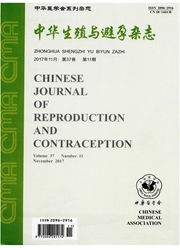

 中文摘要:
中文摘要:
目的:探寻小鼠睾丸支持细胞不同发育阶段和功能状态下的特异性标志蛋白。方法:通过对小鼠睾丸组织进行免疫组织化学染色和实时定量(real-time)RT-PCR,观察受精后16 d胚胎(E16)到出生后6周的雄性小鼠睾丸组织蛋白和m RNA表达。结果:雄激素受体(AR)在出生后1周、2周、6周小鼠的睾丸支持细胞、外周小管肌样细胞、间质细胞细胞核内都有表达,且表达量逐渐增强,但在E16不表达;Wilms肿瘤基因(WT1)在E16、出生后1周、2周、6周的睾丸支持细胞细胞核内表达,但不表达于其它细胞;苗勒氏管抑制素(AMH)在E16、出生后2周的睾丸支持细胞胞质中表达,而在出生后6周不表达;β-链蛋白(β-catenin)和胞质紧密粘连蛋白-1(Zo-1)是血睾屏障特异性蛋白,出生后2周时它们分布于整个曲细精管,而出生后4周时规则地分布于靠近外壁的一圈,此时它们的血睾屏障已经完全建立。Real-time PCR分析睾丸组织m RNA表达,佐证了这些结果。结论:WT1可以作为支持细胞的特异性标志,而AMH则标记不成熟的睾丸支持细胞;AR单独不适合作为睾丸支持细胞的标志物,但与其他标志物结合,可能可区分睾丸支持细胞的成熟与否。而通过β-catenin和Zo-1染色,可以判断血睾屏障是否完全形成,为支持细胞是否成熟提供判断标记。
 英文摘要:
英文摘要:
Objective: To examine whether some markers are regarded as accuracy label of Sertoli cells at different development stages, function status of Sertoli cells. Methods: By immunohistochemical staining and real-time PCR methods, the expression of Sertoli cell marker in testis were examined from embryo period 16 d(E16) to 6 weeks after birth. Results: Protein expression of androgen receptor(AR) was observed in nucleus of Sertoli cells, peritubular myoid cells and Leydig cells in 1 week, 2-week, 6-week old mice. Protein expression of Wilms tumour gene 1(WT1) was observed in Sertoli cells' nucleus in E16 and 1 week, 2 weeks, 6 weeks after birth. Protein expression of anti-Müllerian hormone(AMH) was observed in Sertoli cells' cytoplasm at E16-2 weeks after birth. Until postnatal 4-week blood testis barrier(BTB) complex protein β-catenin, Zonula occludens-1(Zo-1) only expressed near basement memberane of seminiferous tubule. By analysis of mR NA expression of testis, these results were confirmed. Conclusion: WT1 could be regarded as protein marker of Sertoli cells at all the development stages. AMH could be regarded as an immature protein marker of Sertoli cells. AR could not be regarded as protein marker of Sertoli cells, but could be a mature marker of Sertoli cells if it is co-immunofluorescence stained with another Sertoli cell marker. By stainning β-catenin or Zo-1, we could judge whether or not Sertoli cells create BTB fully and Sertoli cells is mature.
 同期刊论文项目
同期刊论文项目
 同项目期刊论文
同项目期刊论文
 期刊信息
期刊信息
